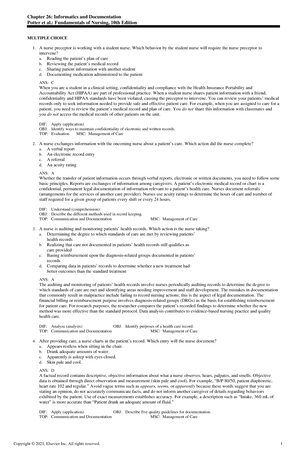- Information
- AI Chat
This is a Premium Document. Some documents on Studocu are Premium. Upgrade to Premium to unlock it.
Was this document helpful?
This is a Premium Document. Some documents on Studocu are Premium. Upgrade to Premium to unlock it.
Exam View - Chapter 25
Course: Fundamentals of Nursing (NUR100)
133 Documents
Students shared 133 documents in this course
University: Fortis College
Was this document helpful?
This is a preview
Do you want full access? Go Premium and unlock all 8 pages
Access to all documents
Get Unlimited Downloads
Improve your grades
Already Premium?

Copyright © 2021, Elsevier Inc. All rights reserved. 1
Chapter 25: Patient Education
Potter et al.: Fundamentals of Nursing, 10th Edition
MULTIPLE CHOICE
1. A nurse is teaching a patient’s family member about permanent tube feedings at home. Which purpose of patient education is the
nurse meeting?
a. Health promotion
b. Illness prevention
c. Restoration of health
d. Coping with impaired functions
ANS: D
Teach family members to help the patient with health care management (e.g., giving medications through gastric tubes and doing
passive range-of-motion exercises) when coping with impaired functions. Not all patients fully recover from illness or injury. Many
have to learn to cope with permanent health alterations. Health promotion involves healthy people staying healthy, while illness
prevention is prevention of diseases. Restoration of health occurs if the teaching is about a temporary tube feeding, not a permanent
tube feeding.
DIF: Understand (comprehension) OBJ: Identify the purposes of patient education.
TOP: Teaching/Learning MSC: Basic Care and Comfort
2. A nurse is teaching a group of healthy adults about the benefits of flu immunizations. Which type of patient education is the nurse
providing?
a. Health analogies
b. Restoration of health
c. Coping with impaired functions
d. Promotion of health and illness prevention
ANS: D
As a nurse, you are a visible, competent resource for patients who want to improve their physical and psychological well-being. In
the school, home, clinic, or workplace, you promote health and prevent illness by providing information and skills that enable
patients to assume healthier behaviors. Injured and ill patients need information and skills to help them regain or maintain their
level of health; this is referred to as restoration of health. Not all patients fully recover from illness or injury. Many have to learn to
cope with permanent health alterations; this is known as coping with impaired functions. Analogies supplement verbal instruction
with familiar images that make complex information more real and understandable. For example, when explaining arterial blood
pressure, use an analogy of the flow of water through a hose.
DIF: Understand (comprehension) OBJ: Identify the purposes of patient education.
TOP: Teaching/Learning MSC: Health Promotion and Maintenance
3. A nurse’s goal is to provide teaching for restoration of health. Which situation indicates the nurse is meeting this goal?
a. Teaching a family member to provide passive range of motion for a stroke patient
b. Teaching a woman who recently had a hysterectomy about possible adoption
c. Teaching expectant parents about changes in childbearing women
d. Teaching a teenager with a broken leg how to use crutches
ANS: D
Injured or ill patients need information and skills to help them regain or maintain their levels of health. An example includes
teaching a teenager with a broken leg how to use crutches. Not all patients fully recover from illness or injury. Many have to learn
to cope with permanent health alterations. New knowledge and skills are often necessary for patients and/or family members to
continue activities of daily living. Teaching family members to help the patient with health care management (e.g., giving
medications through gastric tubes, doing passive range-of-motion exercises) is an example of coping with long-term impaired
functions. For a woman with a hysterectomy, teaching about adoption is not restoration of health; restoration of health in this
situation would involve activity restrictions and incision care if needed. In childbearing classes, you teach expectant parents about
physical and psychological changes in the woman and about fetal development; this is part of health maintenance.
DIF: Apply (application) OBJ: Identify the purposes of patient education.
TOP: Teaching/Learning MSC: Basic Care and Comfort
4. A nurse attends a seminar on teaching/learning. Which statement indicates the nurse has a good understanding of
teaching/learning?
a. “Teaching and learning can be separated.”
b. “Learning is an interactive process that promotes teaching.”
c. “Teaching is most effective when it responds to the learner’s needs.”
d. “Learning consists of a conscious, deliberate set of actions designed to help the
teacher.”
ANS: C
Teaching is most effective when it responds to the learner’s needs. It is impossible to separate teaching from learning. Teaching is
an interactive process that promotes learning. Teaching consists of a conscious, deliberate set of actions that help individuals gain
new knowledge, change attitudes, adopt new behaviors, or perform new skills.
DIF: Understand (comprehension)
OBJ: Describe the similarities and differences between teaching and learning.
TOP: Evaluation MSC: Health Promotion and Maintenance
Why is this page out of focus?
This is a Premium document. Become Premium to read the whole document.
Why is this page out of focus?
This is a Premium document. Become Premium to read the whole document.




